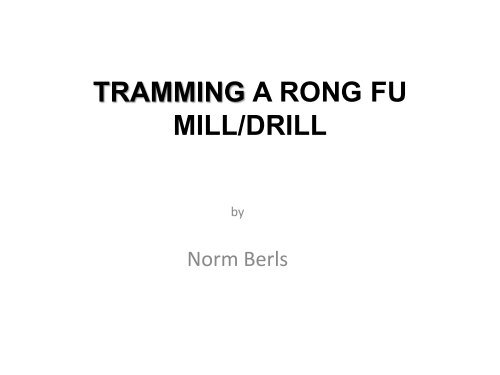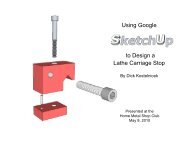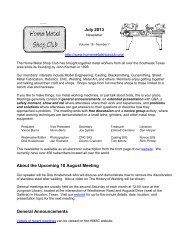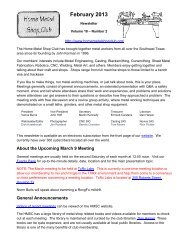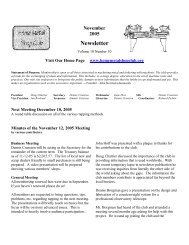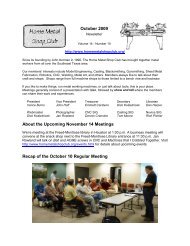Tramming a Rong-Fu Drill/Mill - Home Metal Shop Club
Tramming a Rong-Fu Drill/Mill - Home Metal Shop Club
Tramming a Rong-Fu Drill/Mill - Home Metal Shop Club
You also want an ePaper? Increase the reach of your titles
YUMPU automatically turns print PDFs into web optimized ePapers that Google loves.
TRAMMING A RONG FUMILL/DRILLbyNorm Berls
Point of View• I’m a novice and, this is a voyage of discovery.• As I encountered problems, had to engage in aseries of supporting minor projects to achievethe main goal.• Presentation contains many details that I findinteresting.• Hope they interest everyone.
The <strong>Rong</strong> <strong>Fu</strong> <strong>Mill</strong>/<strong>Drill</strong>• 1.5 horsepower motor.• Multiple speeds via compound beltdrive.• Head swings side to side and movesup and down on smooth verticalcolumn.• Work table has T slots and movesforward-backward, left-right ondovetail ways.• Spindle will hold collet or drill chuck.• 0.5 inches practical limit of cuttingtools.• 0.050 inches practical limit for depthof cut.• Circular column makes head proneto twisting.
2008 – 09 12 studerande2009 – 10 17 studerandeUnder de undersökta åren (5 år) har samtliga fjärdeårsstuderande rymts ini ordinarie grupper, vilket lett till att de inte orsakat några extra kostnaderför lärarresurser.Övriga kostnader ära) Mat, ca 1,80 €/person råvarukostnader för mat. I allmänhet studeradefyraåringarna tre perioder, varefter de avlägger resterandestudentskrivningar. Matkostnaderna blir således i snitt för helaläsårets grupp på 13 studerande ca 2.700 € (114 dagar x 1,80 x 13 =2.667,60).b) Studiestöd (studiebidrag och hyresbidrag) utgör för årets trettonstuderande ca 23.000 €, varav 17.000 € är studiepenning och 6.000 ärbostadsbidrag €. Uppgifterna har presenterats av Ams.Uppskattningsvis är således kostnaden för en fyraårsstuderande ca 1.980€ inklusive studiestöd. De förhållandevis låga kostnaderna beror på attstuderande kan placeras in i befintliga grupper eftersom deras val avkurser är spridda över årskurser.Förslag: Antecknas för kännedom.Beslut: Antecknades för kännedom.§ 75 Fastställande av avgifterStyrelsen ska i enlighet med landskapslagen om gymnasieutbildning(2011:13, 43 §) fastställa de avgifter som uppbärs för annan undervisningän den som leder till examen.Förslag: Styrelsen fastställer följande avgiftera) Avgift för serveringspass 30 €b) Avgift för hygienkurs 70 € och hygienpass 30 €Vid antagning av studerande till närvårdare inom vuxenutbildningen görsett urvalsförfarande i vilket ingår ett test som genomförs avPsykologtjänst, Seija Andersson. Kostnaderna för testet uppgår till 55 €per studerande.c) Avgift för urvalsprov av sökande till närvårdarutbildningen somvuxenutbildning 25 €Beslut: Förslaget omfattades.§ 76 Inrättande av tjänst
• Placing carefullyselected shimsbetween columnand base shouldtramm the mill.• Example trammprocedureavailable onInternet.How To Tramm
<strong>Tramming</strong> with a dial indicator• Made an adaptor to fitindicator into ½ inchcollet.
<strong>Tramming</strong> with a dial indicator• Leveled the work table with amachinists level and shims under thefeet of the mill.• Freed the belt drive on the spindle.• Spindle could freely rotate to anyposition.• Fixed dial indicator in spindle.• Measured distance from the dialindicator to the work table in leftright(X) and front-back (Y) directions.• When the X distances and the Ydistances are all equal, the mill istrammed.
Shimming the mill• First tried standard steel shims. Nosuccess.• Tried multiple alternatives over periodof one man month. No success.• Tried torque wrench. Sequenced andincremental torquing. No success.• Best result was both Y distances and +Xwere equal. -X was not equal.• Conclusions:– 1) Work table is not flat(error 0.002 – 0.004).– 2) Column is probably not straight (error0.002).– 3) Need new approach to tramming.
• Made a ¾ mild steelmandrel with my lathe.• Turning necessary toremove runout.• Polished mandrel withsilicon carbide abrasivepaper backed by foamsanding block.• Lathe ran at 2000 RPMwhile polishing.• Silicon Carbide Abrasives:150, 220, 400, 600 grit.Made a mandrel
Approximate <strong>Tramming</strong>• Mounted vise on mill andsquared it.• Clamped machinists square invise.• Mounted mandrel in splindle.• Tried to shim so that mandrelwas as close as possible toparallel with the square.• Results unsatisfactory.• Conclusion: tramm of this millcannot be achieved withshims.
An alternative to shimming• Cut four pieces of 5/8 allthreadrod 5 inches long each.• Cleaned up threads with a die.• Screwed rods into base of milland locked them into placewith a jam nut.• Screwed second nut onto eachrod.• Set column on top of secondnut.• Screwed third nut on top ofcolumn.
Yet another attempt to tramm• Set a light behind the mandreland square to illuminate the gapbetween mandrel and square.• Adjusted jam nuts to minimizeand equalize light showingthrough gap.• Checked gap with feeler gage.• Smallest gage (0.0015) would notslide between mandrel andsquare… in both X and Ydirections.• Out of tramm by less than 0.0015inches over distance of fourinches… for this position of viseand mill head.• Approximate Success!
Realities of jam nuts• Preliminary X and Y positionsachieved by adjusting pairs of jamnuts (left-right) (front-rear).• Fine adjustments made at just oneof the four corners at a time.• Tightening top nut will shift trammeven when lower nut not changed.• Final torque achieved by creepingtop and bottom nuts towards eachother.• Conclusion: jam nuts are easier tocontrol and work with than shims.
Retest Tramm• After using the mill andmoving the head, decided toretest the Tramm.• Tramm found to be in error inboth X and Y dimensions.• Purchased HSS tool steel rodsin multiple sizes.• Used ¾ inch rod to re-trammmill.• No light showed betweensquare and HSS rod.• Tramm was apparentlyperfect.
<strong>Fu</strong>ture Things To Try• Spindle square availableon Internet for circa $100.• 5/8 threaded rods for jamnuts were almost tooshort at 5 inches… 6 inchrods would be better.• 5/8 rods have to bethreaded at 11 TPI (NC) tomatch mill base but,upper part could bethreaded at 18 TPI (NF) togive finer control.
<strong>Tramming</strong> Reconsidered• Every time the head is moved up or down toswitch between collet and drill chuck, the trammof the mill is in question.• What matters is the orientation of the spindle tothe workpiece.• Theory: If you can’t exactly tramm the mill,tramming the workpiece will work just as well.• Adjustable parallels would allow tramming ofworkpiece in a vise.• Precision mandrels would allow workpiece to beset parallel to the spindle.
Adjustable Parallel Drawing
Adjustable Parallels• Parallel sets in made in 1/8inch increments.• Sizes range from 0.5 to1.625 (shown).• Made from ¼ inch precisionground low carbon steel(1018).• Adjustable parallels involvea vertical set screw in eitherend.• ½ inch by 8-32 set screws.• Either end of parallel canbe raised or lowered.
Setup with adjustable parallel• Insert adjustableparallel in jaw vise.• Clamp dial indicator inspindle.• Fine adjust spindle tomake dial indicator readzero.
Setup with adjustable parallel• Move vise so that dialindicator is at other endof parallel.• Parallel is 0.065 incheslow at this end.
Setup with adjustable parallel• Insert allen wrench in setscrew.• Adjust parallel upward0.065 inches.• Dial indicator shows parallelis trammed with respect tospindle.• Used ½ inch parallel tosetup cut of 1.625 inchparallel.• 1.625 parallel height varied0.0002 to 0.0003 inches endto end!
Yet another parallel• First set of parallelswere 6 inches long to fitbig vise.• Needed another set 3.2inches long to fit asmaller tool makersvise.
Why two vises?• I prefer to use a vise to hold aworkpiece. Faster setup. Lesscomplicated setup.• Two vises allow workpiece to beoriented in direction of either X or Yaxis of work table.• Here a large 6 inch vise slot isoriented parallel to X axis of worktable.• And a small 3.0 inch vise ispositioned inside the jaws of the 6inch vise.• The 3.0 inch vise slot is orientedparallel to Y axis of work table.
Why two vises?• Power feed allowscontinuous movement ofworkpiece.• Stalled end mill leavesmarred finish.• Power feed makes millingeasier and yields higherquality finish.• Power feed works only in Xdirection of the mill.• Two vises allow workpieceto be oriented to makemaximum use of powerfeed.
Making an adjustable parallel• Used hack saw to cutworkpiece to near final length.• Squared both ends of parallel.• Used wax paper as feeler gageto setup end mill to touchworkpiece.• Moved workpiece to rear tofree wax paper.• Adjusted workpiece for a0.010 cut.• Made the cut.• Same for other end.• Used a steel ruler to measureworkpiece.
Yet another view of end squaring.
<strong>Mill</strong>ing a parallel to correct height• Positioned ½ inch end millat top of work piece.• End mill just touched top.• Moved end mill to sideand lowered it 0.050inches.• 0.050 is about themaximum depth mill willcut.
<strong>Mill</strong>ing a parallel to correct height• First cut underway.• Power feed is movingworkpiece under end mill.• Using ½ inch roughingend mill.• Next lower end mill byanother 0.050 inches.• Repeat until most ofmetal removed fromworkpiece.
<strong>Mill</strong>ing a parallel to correct height• When remaining metal
Notch cutting an adjustable parallel• After parallel cut and finishedto correct length and height.• Need to cut rectangularnotch in either end ofworkpiece.• Paint workpiece with DykemRed.• Use granite surface plate.• Set workpiece against blocksquare.• Scribe cut limits with heightgauge.
• Setup workpiece.• <strong>Drill</strong> two holes in areato be removed.• <strong>Drill</strong> small dimple withcentering drill.• 118 degree drills willdrift without leaddimple.<strong>Mill</strong>ing a notch
• Prefer to remove asmuch metal as possiblewith drill.• <strong>Drill</strong>s are cheaper thanend mills.• One hole drilled, needone more.<strong>Mill</strong>ing a notch
• Setup to mill notch with ¼inch end mill.• First cut slot through center.• Work on left side of slotfrom front to back… tomake sure cutting edge ofend mill advances into thecut.• Work on right side of slotfrom back to front… tomake sure cutting edge ofend mill advances into thecut.<strong>Mill</strong>ing a notch
Setup to drill set screw hole• Setup work piece on top ofadjustable parallel.• Object: drill set screw holesexactly vertical.• Using optical center toposition chuck over scribedcenter.• Discovered $200 optical centerwas off center in both X and Y.• Tested optical center and haveexample showing inaccuracy.• Needed new method to centerdrill bit.
Setup to drill set screw hole• Put HSS point fromscribe into chuck.• Centered it over scribedcenter using smallmagnifying glass.• A tedious andsomewhat inaccurateprocedure.
Youtube demos edge finder• Have had edge finder for 6months but did not know howto use it.• Found a demo on Youtube thatshowed how to use an edgefinder.• Changed to using edge finderfor setups.• Here drill chuck is in motionand edge finder has just kickedout to the left.• Continuing to scribe parts onsurface plate: it makes a niceposition check against theedge finder.
Making a lead dimple• Use center drill to dimplework piece.• Small dimple shouldcenter up on scribe marksfollowing positioning offedge of workpiece.• Check with magnifyingglass.• <strong>Drill</strong> dimple deeper.• 1/8 drill has 118 pointangle. Will drift withoutsubstantial lead dimple.
<strong>Drill</strong>ing a 1/8 inch hole.• <strong>Drill</strong>ing 1/8 inch hole.• <strong>Drill</strong>ed through one sideonly.• Flipped over workpieceto drill other side.
<strong>Drill</strong>ing final hole before tapping• #29 drill (0.136)required for 8-32 tap.• <strong>Drill</strong> #29 hole throughboth top and bottomlead holes.
Supporting <strong>Drill</strong> Chuck Nice For Tapping.• I like T shaped tapwrenches with a centerpost that fits in drillchuck.• Less likely to break tapsthis way.
• Attempt to tap 8-32 threadsresulted in broken tap.• Investigation revealed #29 drillwas too small by 0.004 inches…cheap drills ($75).• Only 10% of numbered drillscorrect. Most too small by0.002 to 0.004 inches.• Only 4 of 26 alphabetic drillscorrect. Errors of 0.006 andmore.• None of the fractional drillswere correct.• ½ inch drill was too small by0.015.Tapping problems
Needed new set of drills• Could not tell quality of drills intool catalog.• Needed to see the drills andmeasure them with micrometer toinsure quality.• Off to Rex Tools.• Generic USA drills were nearly allwithin 0.0005.• R drill was incorrect.• Cobalt alloy… good for tool steelas well as mild steel.• 135 degree point angle… will cutdirectly down without slipping offto side.• $600.
Hard learned lessons about drilling• Never trust the labels in a box of drill bits.• Always measure drill bits with a micrometerbefore using them.• It is easy to confuse drill bits when multiple bitsare in the work area.• Too small a hole leads to broken taps.• Start holes too small and gradually drill thembigger.• Use cheap drills for initial (smaller) holes.• Finish with high quality drills or reamer.
Hard learned lessons about tapping.• Run the drill through the hole to be tapped to insure chuck iscentered exactly over hole.• Use T handle tap holder secured in drill chuck.• Do not expect to complete threads in one pass.• Be sensitive to resistance. Stop and reverse when you senseserious binding.• Taps can break during reverse movement out of hole. If you senseresistance, go forward again just a little, then reverse again. Thiswill break off swarf that is still attached to the workpiece.• Clean tap with paper towel or chip brush.• Clean hole with pipe cleaner.• Resume tapping and expect to have to back out again.
• I tend to forget whichway the work piece willmove when the drivescrew is turned… so…Forgetting Is Easy
• From Micro Mark toolsfor model makers.• Intended for glue.• Works well for oil.• Here with Pennzoil5W-20A Handy Oil Can
Tapping Operations in Review
Case Hardening: The Plan• The adjustable parallels are made from low carbon steel (1018).• Case hardening would help protect the parallels during hard usage.• Internet formula for case hardening mixture:– 13 parts Carbon– 3 parts BaCO3 (Barium Carbonate)– 2 parts NaCO3 (Sodium Carbonate)– 1 part CaCO3 (Calcium Carbonate)• Cover part in compound and seal in stainless steel foil pouch.• Heat to 1750 F and hold there for 8 hours.• Quench in 10% brine solution.• Re-polish and protect with paste wax.
Setup For Case Hardening• Neycraft electric furnace.• Fire bricks• Long pliers• Weldors gloves• Bucket for 10% brinesolution.• Work done outsidebecause of carbonmonoxide considerations.
• Case hardening left hard tarnishon parallel.• Rotary wire brush removed somebut, not all tarnish.• 150 silicon carbide abrasiveremoves tarnish but takes a lot ofwork (30 minutes +).• Best removal procedure involved:– 150 silicon carbide abrasive– Flitz metal polish– Steel block– Pressure.• Finished polishing with 150, 220,400 and 600 grit silicon carbide.After Quenching
• Polishing the adjustableparallels was a lot ofhard work.• Purchased a 4x36 beltand 8 in. disk sander.• Finished polishing theparallels by hand and 3hours later the neededabrasives for the beltdisksander arrived.After Polishing
• File that readily cut 1018skated across casehardened 1018.• Tested untreated 1018 vs.case hardened 1018 withsimple hardness test files.• Untreated 1018 testedout to < 40 Rockwell.• Case hardened 1018tested out to around 50Rockwell.Did It Work?
Result: A Box of Adjustable Parallels• 32 adjustable parallels• 14 pounds• 5-6 months work• $150 worth of steel• $600 worth of drill bits
Conclusions• <strong>Mill</strong> / <strong>Drill</strong> is stable enough and reliableenough to justify installing a DRO on it.• Use of the adjustable parallels will not be animpediment because, even on a perfectlytrammed mill, you still have to do the setupcorrectly or all is for naught.• May consider a coolant system in the future.
Where The Tools Came FromSource• Wholesale Tool• Brownells• MSC• Grizzly• Northern Tool• Rex Tools• Micro Mark• <strong>Home</strong> Depot• EncoTools• <strong>Rong</strong> <strong>Fu</strong> mill/drill• Neycraft furnace.• Big vise, surface plate• Small machinist vise, height gauge• Cheap drill bits• High quality (USA) drill bits• Oil Can, Squares• 1/8 inch drill bit• End <strong>Mill</strong>s, Ground 1018 Steel Stock andmost other tools
The End


